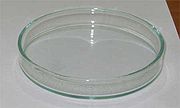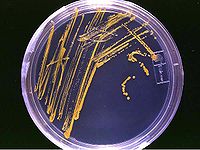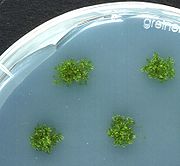
Petri dish
Encyclopedia

A Petri dish is a shallow glass
Glass
Glass is an amorphous solid material. Glasses are typically brittle and optically transparent.The most familiar type of glass, used for centuries in windows and drinking vessels, is soda-lime glass, composed of about 75% silica plus Na2O, CaO, and several minor additives...
or plastic
Plastic
A plastic material is any of a wide range of synthetic or semi-synthetic organic solids used in the manufacture of industrial products. Plastics are typically polymers of high molecular mass, and may contain other substances to improve performance and/or reduce production costs...
cylindrical lidded dish that biologist
Microbiologist
A microbiologist is a scientist who works in the field of microbiology. Microbiologists study organisms called microbes. Microbes can take the form of bacteria, viruses, fungi, and protists...
s use to culture
Microbiological culture
A microbiological culture, or microbial culture, is a method of multiplying microbial organisms by letting them reproduce in predetermined culture media under controlled laboratory conditions. Microbial cultures are used to determine the type of organism, its abundance in the sample being tested,...
cell
Cell (biology)
The cell is the basic structural and functional unit of all known living organisms. It is the smallest unit of life that is classified as a living thing, and is often called the building block of life. The Alberts text discusses how the "cellular building blocks" move to shape developing embryos....
s or small moss plants. It was named after German
Germany
Germany , officially the Federal Republic of Germany , is a federal parliamentary republic in Europe. The country consists of 16 states while the capital and largest city is Berlin. Germany covers an area of 357,021 km2 and has a largely temperate seasonal climate...
bacteriologist Julius Richard Petri
Julius Richard Petri
Julius Richard Petri was a German bacteriologist who is generally credited with inventing the Petri dish while working as assistant to Robert Koch....
, who invented it when working as an assistant to Robert Koch
Robert Koch
Heinrich Hermann Robert Koch was a German physician. He became famous for isolating Bacillus anthracis , the Tuberculosis bacillus and the Vibrio cholerae and for his development of Koch's postulates....
. Glass Petri dishes can be reused by sterilization
Sterilization (microbiology)
Sterilization is a term referring to any process that eliminates or kills all forms of microbial life, including transmissible agents present on a surface, contained in a fluid, in medication, or in a compound such as biological culture media...
(for example, in an autoclave
Autoclave
An autoclave is an instrument used to sterilize equipment and supplies by subjecting them to high pressure saturated steam at 121 °C for around 15–20 minutes depending on the size of the load and the contents. It was invented by Charles Chamberland in 1879, although a precursor known as the...
or by dry heating in a hot air oven at 160°C for one hour). For experiments where cross-contamination from one experiment to the next can become a problem, plastic Petri dishes are often used as disposables.
Modern Petri dishes often have rings on the lids and bases, which allow them to be stacked so that they do not slide off one another. Multiple dishes can also be incorporated into one plastic container to create what is called a "multi-well plate".
Microbiology

Agar plate
An agar plate is a Petri dish that contains a growth medium used to culture microorganisms or small plants like the moss Physcomitrella patens.Selective growth compounds may also be added to the media, such as antibiotics....
s for microbiology studies
Microbiological culture
A microbiological culture, or microbial culture, is a method of multiplying microbial organisms by letting them reproduce in predetermined culture media under controlled laboratory conditions. Microbial cultures are used to determine the type of organism, its abundance in the sample being tested,...
. The dish is partially filled with warm liquid containing agar
Agar
Agar or agar-agar is a gelatinous substance derived from a polysaccharide that accumulates in the cell walls of agarophyte red algae. Throughout history into modern times, agar has been chiefly used as an ingredient in desserts throughout Asia and also as a solid substrate to contain culture medium...
and a mixture of specific ingredients that may include nutrients, blood
Blood
Blood is a specialized bodily fluid in animals that delivers necessary substances such as nutrients and oxygen to the cells and transports metabolic waste products away from those same cells....
, salts, carbohydrates, dyes, indicators, amino acid
Amino acid
Amino acids are molecules containing an amine group, a carboxylic acid group and a side-chain that varies between different amino acids. The key elements of an amino acid are carbon, hydrogen, oxygen, and nitrogen...
s and antibiotic
Antibiotic
An antibacterial is a compound or substance that kills or slows down the growth of bacteria.The term is often used synonymously with the term antibiotic; today, however, with increased knowledge of the causative agents of various infectious diseases, antibiotic has come to denote a broader range of...
s. After the agar cools and solidifies, the dish is ready to receive a microbe-laden sample in a process known as inoculation
Inoculation
Inoculation is the placement of something that will grow or reproduce, and is most commonly used in respect of the introduction of a serum, vaccine, or antigenic substance into the body of a human or animal, especially to produce or boost immunity to a specific disease...
or "plating." For virus or phage cultures, a two-step inoculation is needed: bacteria are grown first to provide hosts for the viral inoculum.
Petri plates are incubated upside down (agar on top) to lessen the risk of contamination from settling airborne particles and to prevent water condensation from accumulating and disturbing the cultured microbes.
Other uses

Cell culture
Cell culture is the complex process by which cells are grown under controlled conditions. In practice, the term "cell culture" has come to refer to the culturing of cells derived from singlecellular eukaryotes, especially animal cells. However, there are also cultures of plants, fungi and microbes,...
in liquid medium or using solid agar. Empty Petri dishes may be used to observe plant germination or small animal behavior, or for other day-to-day laboratory practices such as drying fluids in an oven and carrying and storing samples. Their optical transparency and flat profile lend them to their common use as a temporary receptacle for viewing samples (especially liquid ones) under a low power microscope.

